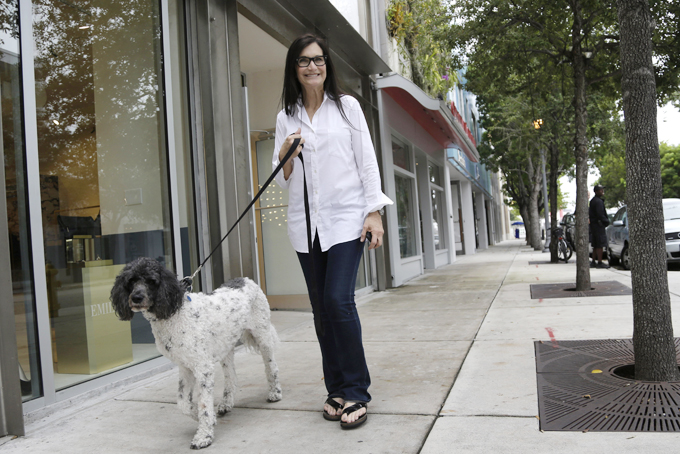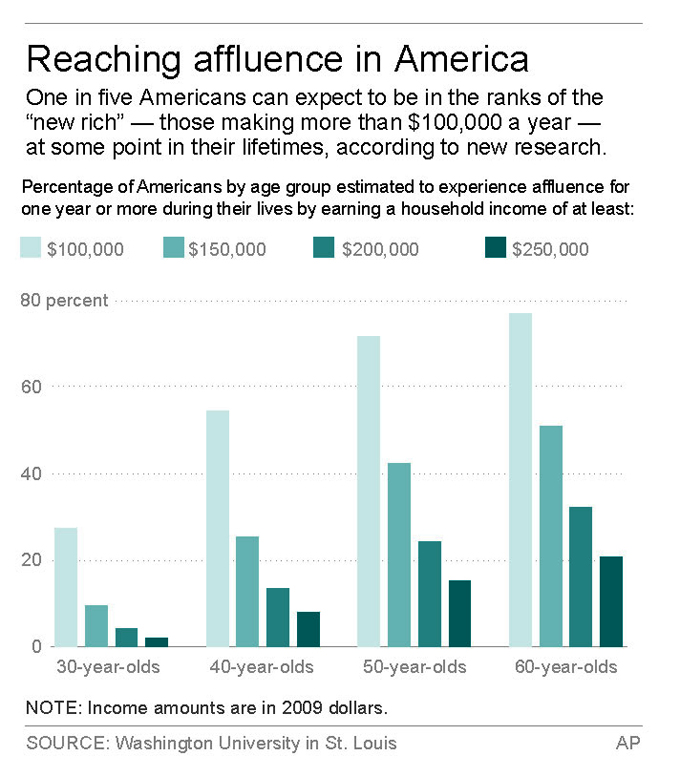
WASHINGTON (AP) — Fully 20 percent of U.S. adults become rich for parts of their lives, wielding extensive influence over America’s economy and politics, according to new survey data.
These “new rich,” made up largely of older professionals, working married couples and more educated singles, are becoming politically influential, and economists say their capacity to spend is key to the U.S. economic recovery. But their rise is also a sign of the nation’s continuing economic polarization.
They extend well beyond the wealthiest 1 percent, a traditional group of super-rich millionaires and billionaires with long-held family assets. The new rich have household income of $250,000 or more at some point during their working lives, putting them — if sometimes temporarily — in the top 2 percent of earners.
The new survey data on the affluent are being published in an upcoming book, and an analysis by The AP-NORC Center for Public Affairs Research provided additional information on the views of the group.

In a country where poverty is at a record high, today’s new rich are notable for their sense of economic fragility. They rely on income from their work to maintain their social position and pay for things such as private tutoring for their children. That makes them much more fiscally conservative than other Americans, polling suggests, and less likely to support public programs, such as food stamps or early public education, to help the disadvantaged.
Last week, President Barack Obama asserted that growing inequality is “the defining challenge of our time,” signaling that it will be a major theme for Democrats in next year’s elections.
“In this country, you don’t get anywhere without working hard,” said James Lott, 28, a pharmacist in Renton, Wash., who adds to his six-figure salary by day-trading stocks. The son of Nigerian immigrants, Lott says he was able to get ahead by earning an advanced pharmacy degree. He makes nearly $200,000 a year.

After growing up on food stamps, Lott now splurges occasionally on nicer restaurants, Hugo Boss shoes and extended vacations to New Orleans, Atlanta and parts of Latin America. He believes government should play a role in helping the disadvantaged. But he says the poor should be encouraged to support themselves, explaining that his single mother rose out of hardship by starting a day-care business in their home.
The new research suggests that affluent Americans are more numerous than government data depict, encompassing 21 percent of working-age adults for at least a year by the time they turn 60. That proportion has more than doubled since 1979.
Even outside periods of unusual wealth, members of this group generally hover in the $100,000-plus income range, keeping them in the top 20 percent of earners.
At the same time, an increasing polarization of low-wage work and high-skill jobs has left middle-income careers depleted.
“For many in this group, the American dream is not dead. They have reached affluence for parts of their lives and see it as very attainable, even if the dream has become more elusive for everyone else,” says Mark Rank, a professor at Washington University in St. Louis, who calculated numbers on the affluent for a forthcoming book, “Chasing the American Dream,” to be published by the Oxford University Press.
As the fastest-growing group based on take-home pay, the new rich tend to enjoy better schools, employment and gated communities, making it easier to pass on their privilege to their children.
Because their rising status comes at a time when upward mobility in the U.S. ranks lowest among wealthy industrialized counties, the spending attitudes of the new rich have implications for politics and policy. It’s now become even harder for people at the bottom to move up.
The group is more liberal than lower-income groups on issues such as abortion and gay marriage, according to an analysis of General Social Survey data by the AP-NORC Center for Public Affairs Research. But when it comes to money, their views aren’t so open. They’re wary of any government role in closing the income gap.
In Gallup polling in October, 60 percent of people making $90,000 or more said average Americans already had “plenty of opportunity” to get ahead. Among those making less than $48,000, the share was 48 percent